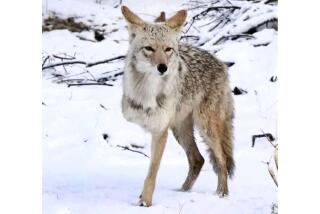‘Watchdonkey’ Guards Sheep in Canada
- Share via
VERMILLION, Canada — What is gray, fleet of hoof and the scourge of coyotes? McGovern the watchdonkey.
McGovern is part of an Alberta government experiment in coyote control that seems to be working.
When the donkey arrived, Bliss Dickson called him Government. That seemed a bit stilted, so Dickson tried Governor for a while, then settled on McGovern.
The 6-year-old gelding prowls the meadows of Dickson’s sheep farm east of Vermillion, watching over his 200 ewes and lambs.
“I’m not saying it works 100%,” Dickson said during a stroll on his land in east-central Alberta, “but I’ve had no losses at all since I’ve had him. That’s been about a year now.”
Recently, Dickson said, one of his neighbors saw McGovern quickly drive the sheep into a tight flock when two coyotes showed themselves on a nearby hill.
“It works,” he said, “and that’s a testament to it.”
John Bourne, the provincial Agriculture Ministry’s regional supervisor for problem wildlife, said the number of coyotes in Alberta had increased, and losses of sheep and cattle had gone up with it.
“We probably have a fraction of 1% losses due to coyotes: 1,500 lambs, 500 to 700 cattle,” he said. “It’s not significant to the industry, but it is significant to individual producers.”
Alberta’s coyote-control program has allowed supervised use of poisons for years. Now the authorities have begun looking at prevention.
Bourne said he had received “enough messages from environmentalists and little old ladies in tennis shoes.”
The ministry studied electric fencing, which had positive but limited applications, and considered guard dogs, then moved on to donkeys.
“Donkeys have an innate dislike for members of the dog species, so we’re undertaking a close look at guardian donkeys,” Bourne said.
They are being limited to sheep farms for the moment, he said, and “the only problem we need to look at is their behavior toward sheep--if they become aggressive or apathetic toward sheep.”
Elsie MacKay raised McGovern on her donkey farm west of Vermillion. She has 20 to 25 donkeys and sells them for breeding, as pets or pack animals, for showing and for producing mules. Lately, MacKay has been selling them to the Alberta government for coyote control.
Bridger, another donkey from the herd, works on a farm north of Vermillion.
MacKay also has sent Cuso, Reggie, Flapjack and Farlow to coyote patrol, and two more donkeys have been spoken for. All are geldings.
“I like to put out geldings because they have no problems with, uh, they’ve got nothing else on their minds,” she said.
McGovern has won the confidence of his charges at the Dickson farm. As he lies in the field, playful lambs climb onto his back and jump off. When he decides a change in pasture is required, he trots off and all the sheep follow him like--well, like sheep.
“When he goes out to the field, he is always the first one out and the last one back in,” Dickson said proudly.
Dickson’s only worry after the first year is that McGovern sometimes tries to pick up a lamb by the back of the neck with his mouth. “I get worried he’ll kill the lamb,” the farmer said.
“I was considering a dog at one time, but as long as it works, I prefer a donkey,” Dickson went on.
“A donkey is more compatible to sheep. It feeds the same as sheep. If a dog decides to go killing, he can do a bunch. I’ve lost sheep to my own dog, or to my neighbor’s dog.”
Bourne will make an official report on McGovern’s progress every year for five years.
“I think it’ll be no different that dogs or fencing,” Bourne said. “It will prove itself. It will work on certain operations and with certain people and it won’t work for others.”
More to Read
Sign up for Essential California
The most important California stories and recommendations in your inbox every morning.
You may occasionally receive promotional content from the Los Angeles Times.













